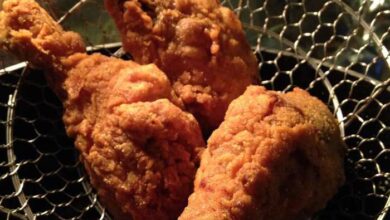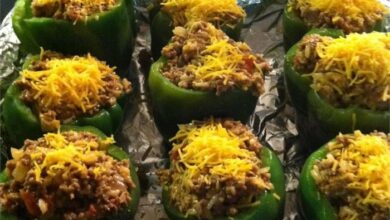
Herbed Prime Rib Roast with Red Wine Sauce: A Feast for the Senses
Herbed prime rib roast with red wine sauce takes center stage, a culinary masterpiece that promises to tantalize your taste buds and impress your guests. This classic dish, with its rich history and undeniable elegance, is a celebration of flavors, textures, and aromas.
From the succulent prime rib, expertly seasoned with a fragrant blend of herbs, to the velvety red wine sauce that envelops each bite, this recipe is a testament to the art of cooking. Whether you’re a seasoned chef or a culinary novice, this guide will equip you with the knowledge and techniques to create a truly memorable dining experience.
Prepare to embark on a culinary journey as we explore the intricacies of selecting the perfect prime rib cut, mastering the art of roasting, and crafting a red wine sauce that will elevate your dish to new heights. From understanding the importance of a herbed rub to the nuances of achieving the ideal level of doneness, this comprehensive guide will leave you confident in your ability to prepare a prime rib roast that will become a family favorite.
Prime Rib Roast: Herbed Prime Rib Roast With Red Wine Sauce
The heart of this culinary masterpiece lies in the prime rib roast itself. This cut of beef, renowned for its tenderness and rich flavor, is a true testament to the art of butchery. Understanding the nuances of prime rib cuts and proper preparation is crucial for achieving a truly unforgettable dining experience.
Choosing the Right Cut
The ideal prime rib roast for roasting is typically a “standing rib roast,” which includes three to seven ribs, encompassing both the eye of the rib (the most tender portion) and the rib bone. This combination delivers a balanced flavor profile and provides a beautiful presentation.
While bone-in roasts are traditional and offer excellent flavor and moisture retention, boneless options are also readily available. Boneless prime rib roasts are often preferred for their ease of carving and versatility in presentation.
Key Differences
- Bone-in Prime Rib:Offers a richer flavor due to the bone’s contribution during cooking. The bone also helps maintain moisture and ensures even cooking. However, it can be challenging to carve and requires more space in the oven.
- Boneless Prime Rib:Easier to carve and can be shaped into a more uniform roast. It also requires less space in the oven. However, it may lack the intense flavor and moisture retention of a bone-in roast.
Understanding Prime Rib and Standing Rib Roast, Herbed prime rib roast with red wine sauce
The terms “prime rib” and “standing rib roast” are often used interchangeably, but there is a subtle distinction. * Prime Rib:This term generally refers to the cut of beef, specifically the rib section. It encompasses both bone-in and boneless options.
Standing Rib Roast
This refers to the specific cut of prime rib that includes the rib bones. It is typically three to seven ribs long and is often considered the “classic” prime rib roast.
Trimming and Tying
Properly trimming and tying a prime rib roast is essential for achieving even cooking and a beautiful presentation.
Trimming
1. Remove Excess Fat
Using a sharp knife, trim away any excess fat from the roast, leaving a thin layer of fat for flavor and moisture.
2. Shape the Roast
Trim the roast into a more uniform shape, if desired. This helps ensure even cooking and a more appealing presentation.
3. Score the Fat
For a crispy, flavorful crust, score the remaining fat layer with a sharp knife, creating a diamond pattern.
Tying
1. Use Butcher’s Twine
Butcher’s twine is ideal for tying the roast securely.
2. Tie in Intervals
Tie the roast at intervals of about 2 inches, ensuring that the twine is tight but not constricting.
3. Secure the Ends
Tie the ends of the twine together to secure the roast.
Herbed Rub

A flavorful herbed rub is the key to elevating your prime rib roast to a whole new level of deliciousness. This aromatic blend of herbs and spices will create a beautiful crust on the outside while infusing the meat with rich, savory notes.
Ingredients of a Classic Herbed Rub
A classic herbed rub typically includes a combination of herbs and spices that complement the rich flavor of prime rib.
Here is a basic recipe for a classic herbed rub:
- Salt:Salt is essential for drawing out moisture from the meat and creating a flavorful crust. Use kosher salt for its larger crystals, which help to season more evenly.
- Black Pepper:Freshly ground black pepper adds a pungent, earthy flavor that balances the richness of the prime rib.
- Garlic Powder:Garlic powder provides a subtle garlicky aroma and flavor that enhances the overall taste.
- Onion Powder:Onion powder adds a sweet and savory note that complements the other ingredients in the rub.
- Dried Thyme:Dried thyme offers a warm, earthy flavor that pairs well with red meat.
- Dried Rosemary:Dried rosemary provides a slightly bitter, piney flavor that adds complexity to the rub.
- Dried Oregano:Dried oregano adds a slightly pungent, earthy flavor that complements the other herbs in the rub.
The Importance of Salt and Pepper in the Rub
Salt and pepper are crucial components of any herbed rub. They not only enhance the flavor but also play a role in creating a delicious crust on the prime rib.
- Salt:Salt draws out moisture from the meat, which helps to create a flavorful crust during cooking. It also helps to tenderize the meat by breaking down muscle fibers.
- Pepper:Pepper adds a pungent, earthy flavor that balances the richness of the prime rib. It also helps to create a crispy crust.
Fresh Herbs vs. Dried Herbs
While dried herbs are convenient, fresh herbs offer a more intense flavor and aroma.
- Fresh Herbs:Fresh herbs have a brighter, more vibrant flavor that can elevate the taste of your prime rib. However, they tend to lose their flavor quickly once they are dried.
- Dried Herbs:Dried herbs are more concentrated in flavor than fresh herbs, so you’ll need to use less. They are also more convenient to store and have a longer shelf life.
A herbed prime rib roast with red wine sauce is a classic holiday dish that always impresses, but sometimes you need something sweet to balance out the savory. That’s where a slice of chef johns holiday pumpkin bread comes in.
It’s the perfect complement to the rich flavors of the roast, and the warm spices in the bread really bring out the flavors of the red wine sauce.
There’s something about a herbed prime rib roast with red wine sauce that just screams “special occasion.” It’s rich, flavorful, and perfect for sharing with loved ones. But sometimes, you crave something a little more comforting, like a hearty slow cooker chicken pot pie.
Both dishes are fantastic in their own right, and offer a different kind of warmth and satisfaction. After all, a delicious meal is a delicious meal, no matter what’s on the menu!
The herbed prime rib roast with red wine sauce is a showstopper, but you can’t forget about dessert! For a perfect ending to your meal, consider a classic blue ribbon apple crumb pie. The sweet, cinnamon-spiced filling and buttery crumb topping will be a delicious contrast to the savory flavors of the prime rib.
And don’t forget to drizzle some of that leftover red wine sauce over the pie for a touch of unexpected decadence.






